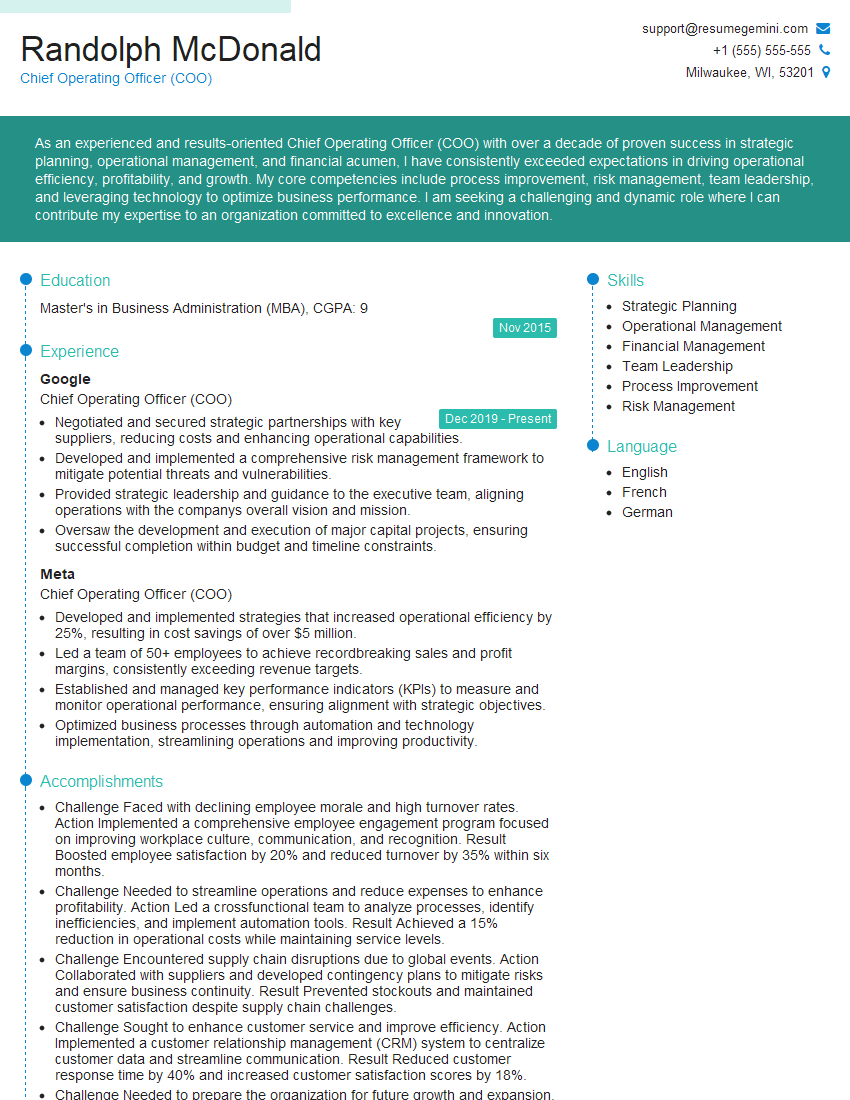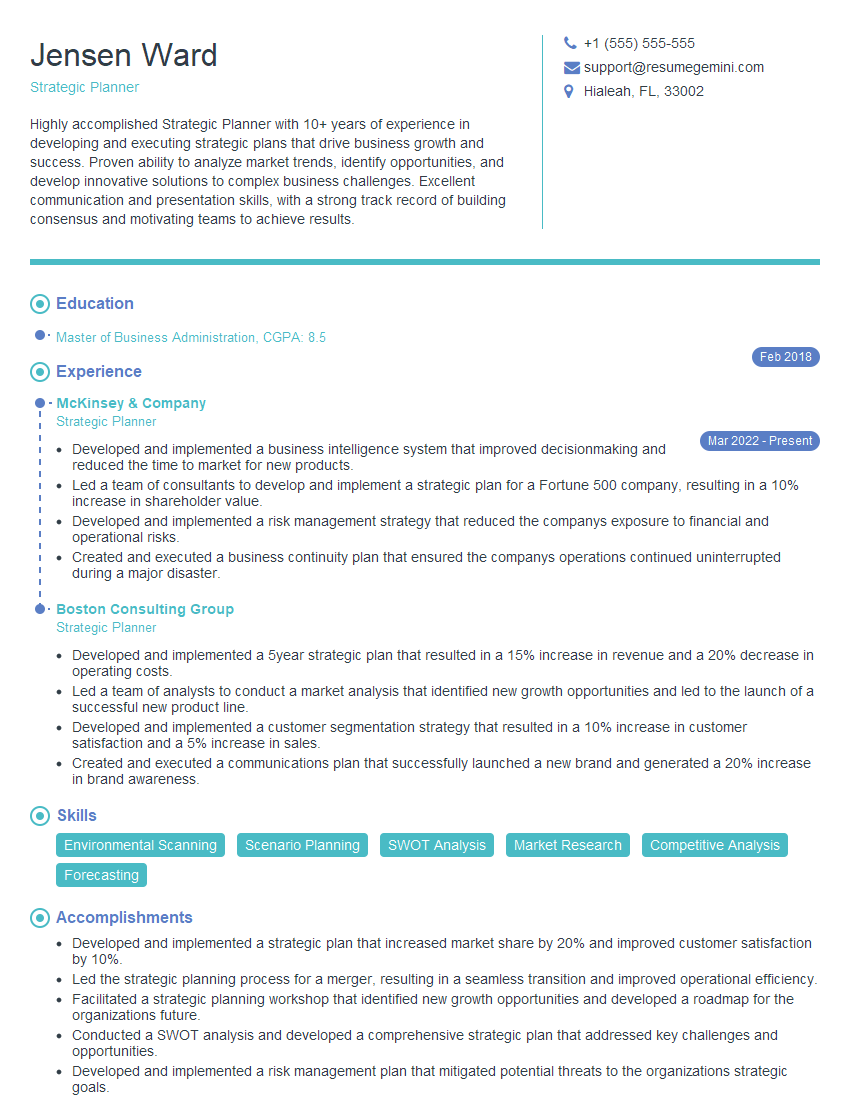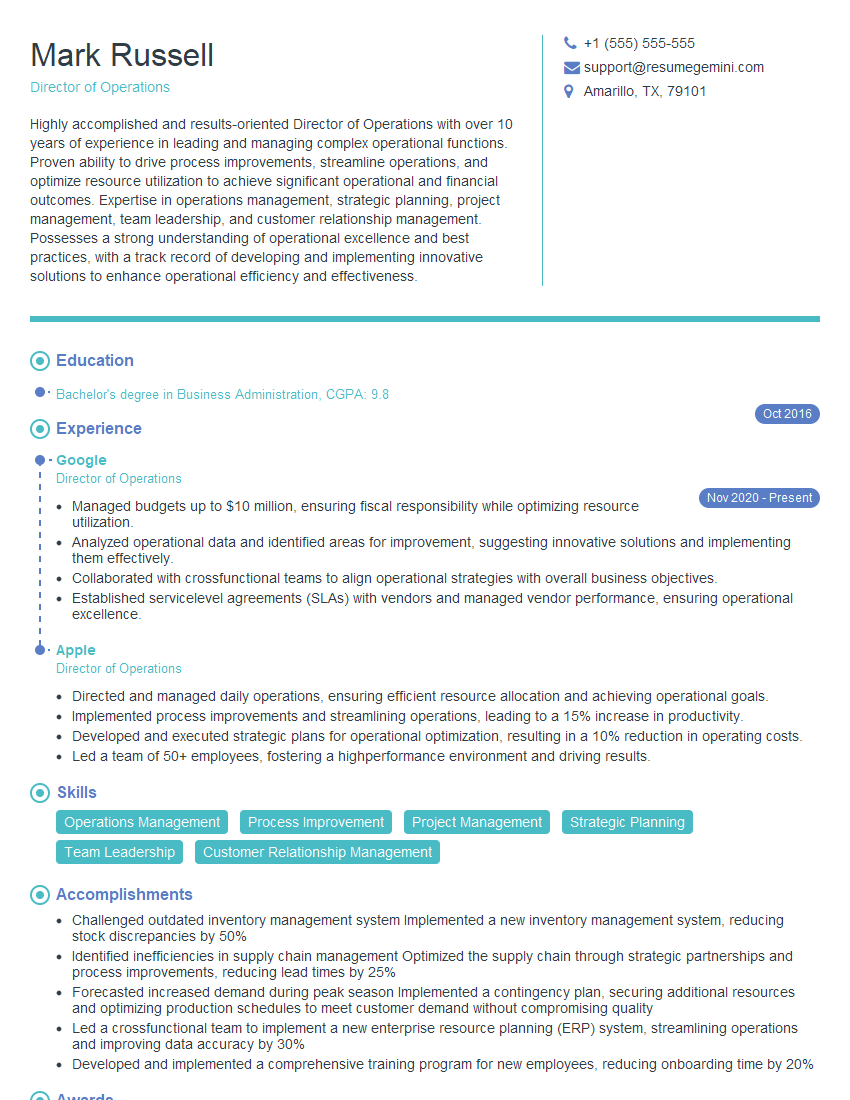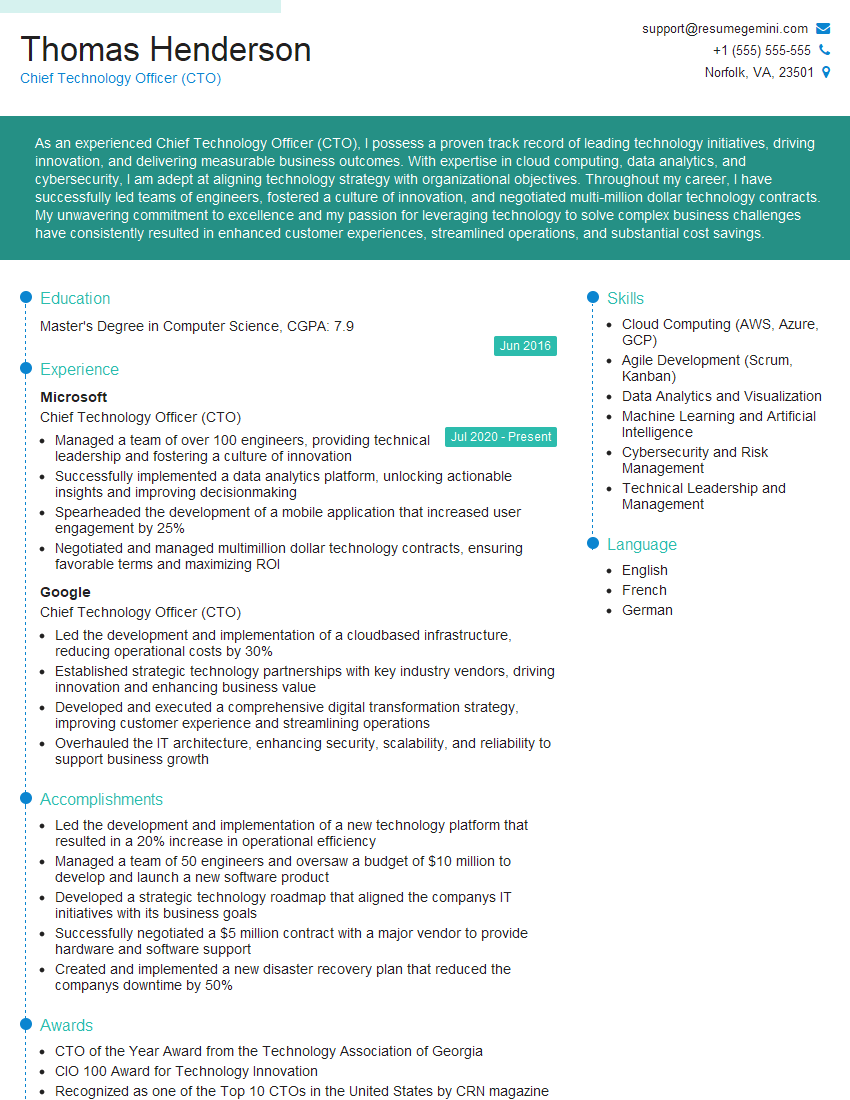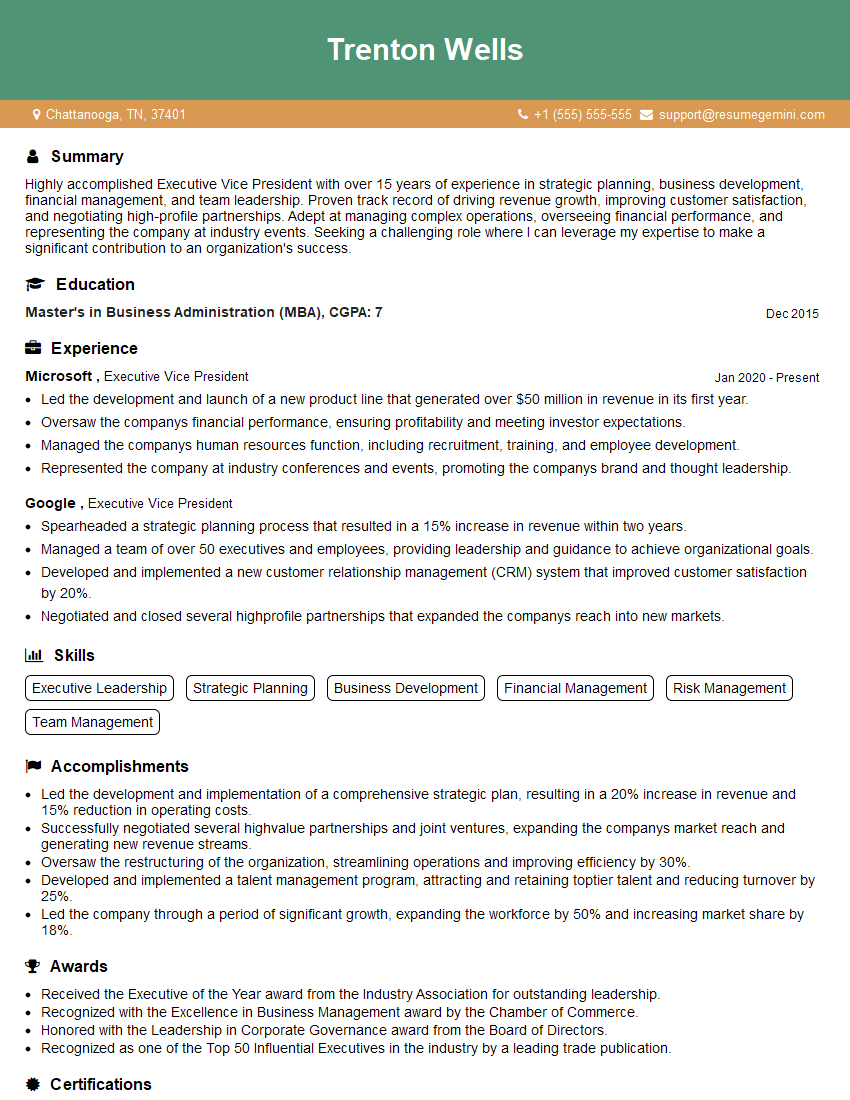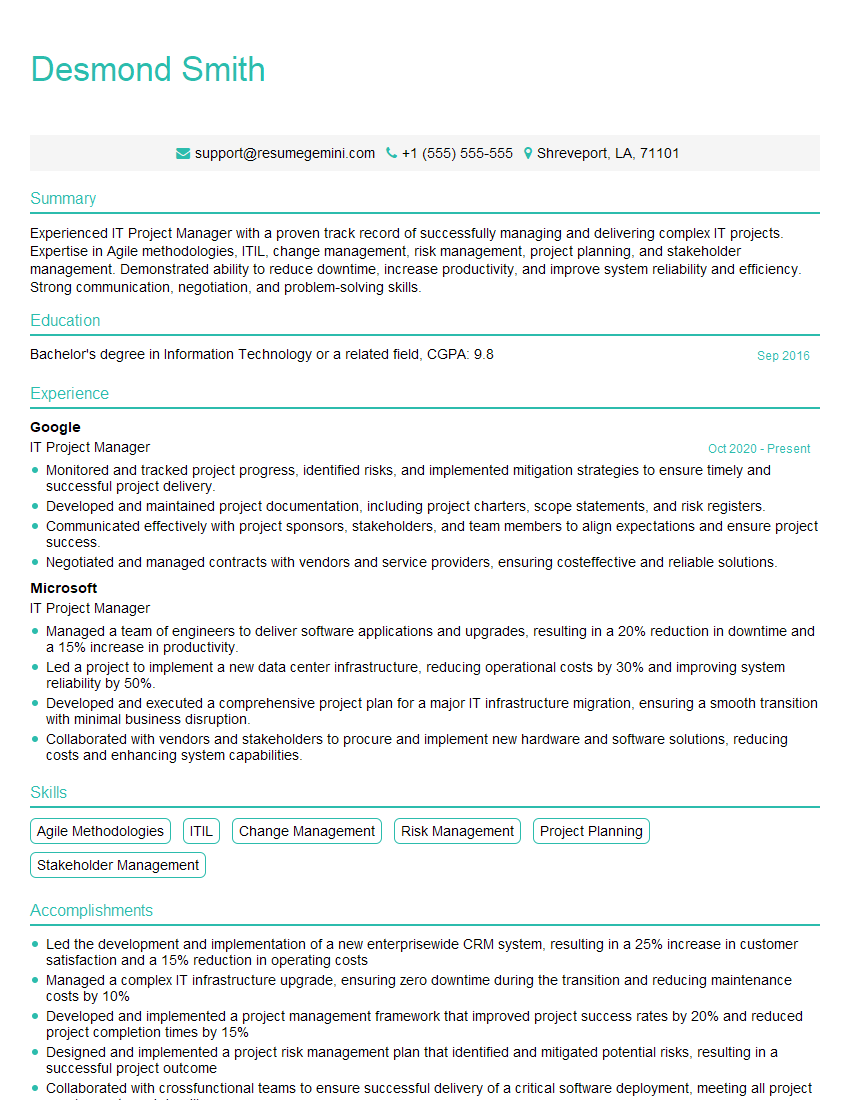Are you ready to stand out in your next interview? Understanding and preparing for Strong problem-solving and decision-making skills interview questions is a game-changer. In this blog, we’ve compiled key questions and expert advice to help you showcase your skills with confidence and precision. Let’s get started on your journey to acing the interview.
Questions Asked in Strong problem-solving and decision-making skills Interview
Q 1. Describe your approach to solving a complex problem with limited information.
When faced with a complex problem and limited information, my approach is systematic and iterative. It begins with clearly defining the problem itself. This often involves asking clarifying questions to gather as much information as possible, even if it seems tangential. I then prioritize the available data and identify the most critical unknowns. This might involve creating a simple risk matrix to assess the impact of missing information.
Next, I develop a hypothesis or several working theories about the problem’s root cause. These hypotheses should be testable, even with limited data. I’ll employ a process of elimination, testing each hypothesis with the information I have. This could involve simple calculations, data analysis of available metrics, or even brainstorming sessions to explore potential scenarios.
Finally, I acknowledge the inherent uncertainty. I document my assumptions and limitations, ensuring transparency and adaptability. If the initial approach proves insufficient, I revisit the problem definition and refine my hypotheses based on the new learnings. It’s crucial to iterate and adjust the strategy as more information emerges. Think of it like solving a jigsaw puzzle with missing pieces; you work with what you have, focusing on the areas you can assemble, and patiently waiting for more pieces to emerge.
Q 2. Explain a time you had to make a difficult decision with significant consequences.
During a previous project, our team faced a critical deadline for a major software release. We discovered a significant bug in the core functionality, just days before launch. The consequences of releasing with this bug were severe – potential loss of client trust, significant financial repercussions, and reputational damage. We had three options: postpone the launch, release with the bug (mitigating its impact as much as possible), or release a severely truncated version of the software, delaying full functionality.
Postponing the launch wasn’t an option due to contractual obligations. Releasing with the bug, while potentially less damaging than a truncated release, risked major client issues. A smaller, incomplete release bought us more time, but jeopardized immediate client satisfaction. After weighing the risks and consequences of each option with the team, considering client impact and potential PR fallout, we opted to release a truncated version with a clear communication plan, promptly addressing the bug with a subsequent patch. This decision, while challenging, prevented greater long-term damage and preserved our client relationships. The experience highlighted the importance of clear communication and risk assessment during crisis management.
Q 3. How do you prioritize competing tasks and deadlines?
I prioritize competing tasks using a combination of techniques, primarily the Eisenhower Matrix (urgent/important). This matrix helps categorize tasks into four quadrants: urgent and important, important but not urgent, urgent but not important, and neither urgent nor important. This allows me to focus my energy on the most critical tasks first.
Further, I use project management tools to schedule and track deadlines, ensuring that time-sensitive tasks are clearly identified. I often break down large tasks into smaller, manageable steps, making them less daunting and easier to schedule. Regular review and adjustment of priorities is key; unexpected issues can arise, requiring recalibration. It’s also vital to communicate task priorities effectively with team members to ensure everyone is aligned and working efficiently.
For example, if I have a looming deadline for a client presentation (urgent and important) and a long-term strategic planning task (important but not urgent), the presentation takes precedence. However, I’ll still allocate time for the strategic planning task, even if it’s in smaller chunks, to ensure it doesn’t get completely neglected.
Q 4. Describe your process for analyzing data to identify key insights.
My data analysis process is driven by a clear objective. Before diving into the data, I define the specific questions I want to answer. This ensures that my analysis is focused and efficient. I then gather and cleanse the data, handling missing values and outliers appropriately. The choice of cleaning methods depends heavily on the nature of the data and the analysis goals.
Next, I choose appropriate analytical methods based on the data type and the research questions. This might involve descriptive statistics, regression analysis, or more advanced techniques like machine learning algorithms. I always visualize the data, using charts and graphs to identify patterns and trends. Visualization allows for quicker identification of anomalies and insights that might be missed in raw numerical data.
Finally, I interpret the results, drawing conclusions that directly answer the initial questions. It is crucial to communicate the findings clearly and concisely, emphasizing the implications for decision-making. This might involve creating reports, presentations, or dashboards tailored to the audience’s needs. For instance, if I’m analyzing website traffic data, I might use line charts to visualize trends over time and heatmaps to identify geographical patterns.
Q 5. How do you identify and mitigate potential risks in a project?
Risk identification and mitigation is a proactive process that starts at the project planning stage. I use a combination of techniques, including brainstorming sessions with the team, reviewing past projects for similar challenges, and conducting thorough risk assessments. These assessments often involve identifying potential risks, assessing their likelihood and impact, and developing mitigation strategies.
A risk register is a valuable tool in this process, providing a centralized repository for documenting identified risks, their potential impacts, mitigation plans, and assigned owners. Regular monitoring and updates of the risk register is critical, especially when unexpected challenges arise or new information emerges. This allows for a dynamic approach to risk management, adapting to changing circumstances.
For example, in a software development project, potential risks might include delays in acquiring necessary resources, encountering unforeseen technical challenges, or changes in client requirements. Mitigation strategies could involve establishing contingency plans, investing in robust testing procedures, or incorporating flexible design elements to accommodate potential changes.
Q 6. Give an example of a time you had to adapt your approach to a problem due to unexpected challenges.
In a previous project, we were developing a new mobile application. Our initial approach relied heavily on a specific third-party API for push notifications. However, shortly before our launch date, this API became unexpectedly unavailable due to unforeseen technical issues with the provider. Our original plan was completely disrupted.
We had to quickly adapt. The team immediately explored alternative push notification services, evaluating their capabilities, reliability, and integration complexity. We prioritized a solution that ensured minimal disruption to the app’s core functionality. This required significant extra work and late nights, but we successfully integrated a new service, minimizing the impact on the launch timeline and preventing the failure of the project. The adaptation required flexibility, collaborative problem-solving, and a willingness to deviate from the initial plan when faced with a significant challenge.
Q 7. How do you approach brainstorming solutions to a complex problem?
My approach to brainstorming is collaborative and structured. I typically start by clearly defining the problem and the desired outcome. This sets the stage for a focused discussion. I encourage diverse perspectives and actively solicit input from all participants, promoting open communication and a judgment-free environment.
To structure the brainstorming process, I often employ techniques like mind mapping or SWOT analysis (Strengths, Weaknesses, Opportunities, Threats). Mind mapping allows us to visually explore interconnected ideas, while SWOT analysis helps us assess the potential benefits and risks of different solutions. I always document all ideas generated, even those that initially seem unrealistic. We then evaluate the generated ideas, considering feasibility, cost, and impact, before selecting the most promising options for further development and refinement.
For instance, if we’re trying to improve customer satisfaction, a mind map might branch out from the central theme into customer segments, feedback channels, service improvements, and marketing campaigns. This helps us connect seemingly disparate ideas and discover creative solutions.
Q 8. How do you evaluate the effectiveness of your decisions?
Evaluating the effectiveness of my decisions is a crucial part of continuous improvement. I use a multi-faceted approach that combines pre-defined success metrics, post-implementation analysis, and ongoing monitoring.
- Pre-defined Metrics: Before making a decision, I establish clear, measurable objectives and Key Performance Indicators (KPIs). For example, if I’m deciding on a new marketing campaign, I might define KPIs such as website traffic increase, lead generation, and conversion rates. These provide a benchmark for measuring success.
- Post-Implementation Analysis: After the decision’s implementation, I meticulously analyze the results against the pre-defined KPIs. I use data analytics tools to track progress and identify any deviations from the expected outcomes. This helps me understand what worked well and what didn’t.
- Ongoing Monitoring: Decisions rarely exist in isolation; their impact unfolds over time. I regularly monitor the long-term effects of my decisions, adapting and adjusting as necessary. This ensures that the initial success isn’t fleeting and the decision maintains its positive impact.
For instance, in a previous role, I implemented a new project management software. My pre-defined metrics included reduced project completion time, improved team collaboration, and enhanced task visibility. Post-implementation analysis showed a 15% reduction in project completion time and a significant improvement in team satisfaction based on feedback surveys. This confirmed the effectiveness of my decision.
Q 9. Describe your experience using data-driven decision-making.
Data-driven decision-making is fundamental to my approach. I believe in leveraging data to inform decisions, reducing reliance on intuition alone. My experience encompasses various aspects of data analysis, from data collection and cleaning to interpreting results and making recommendations.
- Data Collection and Cleaning: I’m adept at identifying relevant data sources and employing techniques to clean and prepare the data for analysis, ensuring its accuracy and reliability.
- Data Analysis: I utilize various statistical methods and analytical tools, including spreadsheets, SQL, and business intelligence software, to interpret data patterns and trends.
- Decision Making: I translate data insights into actionable strategies and recommendations, clearly articulating the rationale and potential outcomes.
In a previous project involving optimizing a company’s supply chain, I analyzed sales data, inventory levels, and delivery times. This revealed bottlenecks in the distribution process, leading to a decision to implement a new logistics system. The data showed a projected 10% reduction in delivery times and a 5% decrease in inventory costs, justifying the investment.
Q 10. Explain your approach to conflict resolution within a team.
Conflict resolution is a critical skill in teamwork. My approach centers around fostering open communication, active listening, and finding mutually agreeable solutions. I believe in focusing on the issue at hand, not on personalities.
- Open Communication: I encourage team members to openly express their views and concerns in a respectful manner. I create a safe space where everyone feels comfortable sharing their perspectives.
- Active Listening: I practice active listening, seeking to understand each individual’s point of view before offering my own. This helps to de-escalate tensions and build understanding.
- Collaborative Problem-Solving: I guide the team towards finding common ground and collaborative solutions that address the root causes of the conflict. I facilitate brainstorming sessions and explore various options to arrive at a mutually acceptable outcome.
For example, during a project where team members disagreed on the project timeline, I facilitated a discussion where each member explained their concerns and proposed alternative solutions. Through collaborative problem-solving, we identified a revised timeline that addressed everyone’s needs and kept the project on track.
Q 11. How do you manage conflicting priorities?
Managing conflicting priorities is a common challenge. My approach involves prioritization techniques, effective time management, and clear communication.
- Prioritization: I use methods like Eisenhower Matrix (urgent/important) to categorize tasks and focus on high-impact activities first. This ensures that crucial tasks aren’t neglected.
- Time Management: I utilize time-blocking techniques to allocate specific time slots for different tasks, maximizing productivity and reducing multitasking.
- Communication: I proactively communicate with stakeholders about competing priorities and potential trade-offs, ensuring transparency and alignment of expectations.
For instance, if faced with deadlines for a critical report and a less urgent presentation, I’d prioritize the report using the Eisenhower Matrix. I’d allocate specific blocks of time for each and communicate to stakeholders the adjusted timeline for the presentation.
Q 12. How do you handle pressure when making critical decisions under tight deadlines?
Making critical decisions under tight deadlines requires a calm and structured approach. I manage pressure by staying organized, breaking down complex problems, and focusing on the essential elements.
- Structured Approach: I break down complex problems into smaller, manageable tasks, focusing on one step at a time. This prevents feeling overwhelmed.
- Time Management: I create a realistic timeline for each task and allocate appropriate time slots. This avoids rushing and helps maintain accuracy.
- Stress Management: I utilize techniques such as deep breathing exercises or short breaks to manage stress and maintain clarity of thought.
In a past situation, a critical system failure required immediate resolution. By breaking the problem down into smaller components and delegating tasks effectively, I guided the team towards a swift solution, minimizing downtime and preventing further damage.
Q 13. How do you approach root cause analysis when investigating problems?
Root cause analysis is crucial for preventing future problems. My approach typically involves the ‘5 Whys’ method, coupled with data analysis and a systematic investigation.
- 5 Whys: This technique involves repeatedly asking ‘Why?’ to uncover the underlying causes of a problem. It helps to move beyond superficial symptoms to the root issue.
- Data Analysis: I examine relevant data to support the findings from the ‘5 Whys’ method, providing empirical evidence for the identified root cause.
- Systematic Investigation: I conduct a thorough investigation, gathering information from various sources and interviewing relevant stakeholders to validate the identified root cause.
For example, if a project is consistently delayed, the ‘5 Whys’ method might reveal that the delays are due to inadequate resource allocation, which is rooted in an inaccurate project scope definition.
Q 14. Explain how you measure the success of a decision you made.
Measuring the success of a decision is an ongoing process. I use a combination of quantitative and qualitative metrics to assess the impact of my decisions.
- Quantitative Metrics: These include measurable data points like sales figures, customer satisfaction scores, or project completion times. They provide objective evidence of the decision’s impact.
- Qualitative Metrics: These encompass feedback from stakeholders, observations, and assessments of the overall impact on the organization. They provide valuable contextual information.
- Long-term Monitoring: I track the effects of my decisions over time, assessing their sustainability and long-term benefits.
When I implemented a new training program, quantitative metrics showed a 10% increase in employee productivity. Qualitative feedback from employees highlighted increased job satisfaction and improved skills. This holistic approach provided a comprehensive picture of the decision’s success.
Q 15. Describe a time you made a wrong decision. What did you learn?
Early in my career, I spearheaded a project to streamline our client onboarding process. My initial approach focused solely on automation, believing it would be the fastest and most efficient solution. This overlooked the crucial element of user experience and training. The result was a system that was technically efficient but difficult for our team to use, leading to increased errors and frustration, ultimately slowing down the process.
The valuable lesson learned was the critical need for holistic problem-solving. I now understand that focusing on efficiency alone without considering human factors and thorough testing can lead to unexpected negative consequences. My current approach involves a more iterative process: clearly defining user needs, prototyping solutions, gathering feedback early and often, and then implementing gradual changes, continuously monitoring and refining.
Career Expert Tips:
- Ace those interviews! Prepare effectively by reviewing the Top 50 Most Common Interview Questions on ResumeGemini.
- Navigate your job search with confidence! Explore a wide range of Career Tips on ResumeGemini. Learn about common challenges and recommendations to overcome them.
- Craft the perfect resume! Master the Art of Resume Writing with ResumeGemini’s guide. Showcase your unique qualifications and achievements effectively.
- Don’t miss out on holiday savings! Build your dream resume with ResumeGemini’s ATS optimized templates.
Q 16. How do you incorporate feedback into your problem-solving process?
Feedback is integral to my problem-solving process; I view it as a crucial compass guiding me toward better solutions. I actively solicit feedback at various stages, from initial brainstorming through final implementation. I use a structured approach:
- Active Listening: I ensure I fully understand the feedback given, asking clarifying questions to eliminate any ambiguity.
- Objective Evaluation: I analyze feedback objectively, separating constructive criticism from personal opinions. This helps me identify patterns and trends.
- Iterative Improvement: I incorporate valid feedback into my approach, modifying plans or strategies accordingly. Sometimes this means pivoting completely, other times it’s minor adjustments.
- Documentation: I maintain a record of all feedback received, the decisions made based on that feedback, and the outcomes. This helps me track progress and refine my process over time.
For example, during a recent project, user testing revealed a critical usability issue in our software interface. Feedback pointed towards a confusing navigation system. By incorporating this feedback, we redesigned the navigation, significantly improving user satisfaction and overall project success.
Q 17. How do you stay organized when dealing with multiple projects and responsibilities?
Managing multiple projects and responsibilities effectively requires a structured and organized approach. I utilize a combination of tools and techniques:
- Prioritization Matrix: I employ a prioritization matrix (like Eisenhower Matrix) to categorize tasks based on urgency and importance. This ensures I focus on high-impact tasks first.
- Project Management Software: I use project management software like Asana or Trello to track tasks, deadlines, and progress across all projects. This provides a centralized view of my workload.
- Time Blocking: I schedule specific blocks of time for focused work on individual projects. This minimizes context switching and improves efficiency.
- Regular Review and Adjustment: I regularly review my schedule and adjust priorities as needed. Unexpected issues or changes in priorities require flexible planning.
Thinking of it like a conductor of an orchestra, I need to ensure each section (project) plays its part harmoniously and efficiently, requiring careful planning, coordination, and adaptation.
Q 18. Describe your experience working with cross-functional teams to solve a problem.
In a previous role, we faced a significant challenge: a critical software bug affecting multiple departments. Solving it required a cross-functional team involving engineers, product managers, customer support, and marketing.
My role involved facilitating communication and collaboration. We employed agile methodologies, holding daily stand-up meetings to discuss progress, roadblocks, and necessary adjustments. Open communication and clear task assignments were vital. We used a shared online document to track progress, document decisions, and assign responsibilities, promoting transparency and accountability across teams. This collaborative effort led to a swift resolution and minimized disruption to the business.
Q 19. How do you identify and communicate the potential impact of your decisions?
Identifying and communicating the potential impact of decisions is paramount for effective decision-making. My approach involves:
- Impact Assessment: Before making a decision, I conduct a thorough impact assessment, considering potential consequences on various stakeholders (customers, team members, the organization as a whole).
- Risk Analysis: I identify potential risks and challenges associated with each decision and develop mitigation strategies.
- Clear Communication: I communicate the potential impact of my decisions clearly and transparently to relevant stakeholders, using both written and verbal communication. I tailor my communication style to the audience.
- Data Visualization: Where applicable, I use data visualization tools to present the impact of decisions in a clear and concise manner.
For instance, when deciding on a new marketing campaign, I would present data demonstrating the potential reach, engagement, and ROI, alongside potential risks like negative customer feedback or budget overruns.
Q 20. How do you ensure that your decisions align with overall organizational goals?
Aligning decisions with organizational goals is crucial for overall success. I achieve this through:
- Understanding Organizational Goals: I dedicate time to understand the company’s strategic objectives, mission, and vision. This includes reviewing strategic plans and engaging in discussions with leadership.
- Goal Alignment: Before making any decision, I explicitly consider how it aligns with the organization’s overarching goals. Does this decision support or hinder those goals?
- Data-Driven Decisions: I leverage data and analytics to inform my decisions, ensuring they are aligned with both strategic and operational goals.
- Regular Check-ins: I participate in regular meetings and reviews to discuss progress and ensure that ongoing decisions remain aligned with the evolving strategic direction of the company.
For example, if the company’s goal is to expand into a new market, any decision I make regarding resource allocation, product development, or marketing would directly support that goal.
Q 21. Describe a time you had to make a decision with incomplete data.
In a fast-paced environment, decision-making with incomplete data is sometimes unavoidable. My strategy focuses on:
- Data Gathering: I gather as much relevant data as possible within the available timeframe. This might involve quick surveys, informal discussions, or reviewing readily available reports.
- Identify Critical Information Gaps: I clearly identify the missing information and assess the potential impact of those gaps on the decision.
- Scenario Planning: I develop several scenarios based on different assumptions about the missing data. This helps understand potential outcomes under varying conditions.
- Decision Criteria: I establish clear decision criteria to evaluate each scenario and choose the best course of action based on the available information and identified risks.
- Flexibility and Monitoring: I remain flexible and build in mechanisms to monitor the results of the decision and adjust the course as more information becomes available.
Imagine having to make a decision about whether to launch a product update before receiving complete market research. With incomplete data, I might use available sales figures and social media sentiment to make an informed decision, while accepting that there is inherent uncertainty and being ready to make adjustments later.
Q 22. How do you delegate tasks effectively to facilitate problem-solving?
Effective delegation is crucial for efficient problem-solving. It’s not just about assigning tasks; it’s about empowering individuals to contribute their unique skills and expertise. I approach delegation by first clearly defining the problem and desired outcome. Then, I identify the individuals best suited for specific tasks, considering their strengths, experience, and available capacity. This involves careful assessment of their skill sets and potential for growth. I provide each person with clear instructions, necessary resources, and a defined timeline, ensuring they understand their responsibilities and the overall project goals. Regular check-ins are essential to monitor progress, provide support, and address any roadblocks. Finally, I ensure recognition and appreciation for their contributions to foster a collaborative and positive environment.
For example, during a project involving a website redesign, I delegated the front-end development to a team member with extensive JavaScript experience, while a colleague with strong UX design skills handled the user interface. This division of labor allowed us to leverage each individual’s strengths, leading to a faster and more efficient completion of the project.
Q 23. Explain your experience with using different problem-solving frameworks (e.g., SWOT, 5 Whys).
I have extensive experience using various problem-solving frameworks, adapting them to the specific context of each challenge. The SWOT analysis (Strengths, Weaknesses, Opportunities, Threats) is invaluable for strategic planning, helping to identify internal capabilities and external factors impacting a situation. For example, when considering launching a new product, a SWOT analysis helps weigh potential market advantages against competitive pressures. The 5 Whys technique is excellent for root cause analysis, drilling down to the fundamental reasons behind a problem. By repeatedly asking “Why?” five times, we uncover underlying issues that might otherwise be missed. For instance, if a customer service issue arises, repeatedly asking why might reveal systemic issues within the company’s training processes.
Beyond these, I utilize other frameworks like Fishbone diagrams (Ishikawa diagrams) for visualizing contributing factors and Pareto charts to identify the vital few issues impacting the majority of the problem.
Q 24. How do you utilize analytical tools and techniques to solve problems?
Analytical tools and techniques are indispensable for effective problem-solving. My approach often involves a combination of qualitative and quantitative methods. I leverage statistical software (like R or Python) for data analysis, identifying trends and correlations within datasets. For example, I might use regression analysis to predict future sales based on past performance data. I also employ data mining techniques to unearth hidden patterns and insights that inform decision-making. Data visualization tools, such as Tableau or Power BI, are crucial for communicating findings effectively. Creating clear and concise charts and graphs allows stakeholders to understand complex data quickly and facilitates informed discussions.
In one project, I used SQL to query a large database of customer interactions to identify the root causes of high customer churn. By visualizing the data, we were able to pinpoint specific pain points in the customer journey that needed addressing. This resulted in targeted improvements that reduced churn significantly.
Q 25. Describe a time you had to persuade others to adopt your solution.
Persuading others to adopt a solution requires strong communication and the ability to build consensus. In one instance, I developed a new process for streamlining our project management workflow. Initially, some team members resisted the change due to concerns about the learning curve and potential disruption to their existing routines. To address these concerns, I presented the data demonstrating the inefficiencies in the current system and the projected improvements with the new process. I also created a step-by-step training guide and offered hands-on support during the transition. I actively listened to their concerns, acknowledging their perspectives and addressing them directly with data-backed arguments and examples of successful implementations in similar contexts. This collaborative approach fostered trust and buy-in, ultimately leading to the successful adoption of the new system and demonstrably improved productivity.
Q 26. How do you balance short-term gains with long-term goals when making decisions?
Balancing short-term gains with long-term goals is a constant challenge. My approach involves a thorough cost-benefit analysis that considers both immediate and future implications. I use forecasting and scenario planning to assess the potential long-term effects of different decisions, considering factors like market trends, technological advancements, and regulatory changes. This enables me to make informed choices that prioritize sustainable growth over immediate gratification. For example, when faced with a choice between implementing a quick, inexpensive fix versus investing in a more robust long-term solution, I would carefully analyze the trade-offs. While the quick fix might save money upfront, it could lead to higher costs and inefficiencies in the future. The long-term solution might require a larger initial investment but would ultimately result in significant cost savings and improved performance.
Q 27. How do you ensure that your decisions are ethical and fair?
Ethical and fair decision-making is paramount. My framework involves considering the impact of my decisions on all stakeholders, not just myself or my immediate team. I strive to be objective, unbiased, and transparent in my evaluation of options. I actively seek diverse perspectives and actively look for potential biases that may cloud my judgment. I also ensure compliance with all relevant laws, regulations, and company policies. In situations with ethical dilemmas, I consult with colleagues, mentors, or ethics committees to ensure a thorough and fair assessment of the situation before making a decision. For example, if presented with a situation involving a potential conflict of interest, I would immediately disclose it and seek guidance to ensure compliance with company policy and ethical standards.
Q 28. Describe your experience with using data visualization to communicate insights and recommendations.
Data visualization is essential for communicating complex information clearly and concisely. My experience involves using a range of tools, from simple charts and graphs to interactive dashboards, to effectively present insights and recommendations. I tailor my visualizations to the audience, selecting the most appropriate chart type to represent the data accurately and avoid misinterpretations. For instance, I would use a bar chart to compare the performance of different products, a line chart to show trends over time, and a scatter plot to explore correlations between variables. I believe in keeping visualizations simple, focusing on highlighting key findings and providing clear labels and titles. In one instance, I used interactive dashboards to track key performance indicators (KPIs) for a sales team, allowing them to monitor their progress and identify areas needing improvement in real-time.
Key Topics to Learn for Strong Problem-Solving and Decision-Making Skills Interview
- Defining the Problem: Learn to accurately identify the core issue, separating symptoms from root causes. Practice techniques like root cause analysis (RCA) to uncover underlying problems.
- Gathering Information: Explore strategies for effective information gathering, including asking clarifying questions, conducting thorough research, and analyzing data critically. Consider the impact of bias in data interpretation.
- Evaluating Options: Master frameworks like decision matrices and cost-benefit analysis to objectively weigh different solutions. Practice prioritizing options based on impact, feasibility, and risk.
- Decision-Making Models: Familiarize yourself with various decision-making models (e.g., rational, intuitive, bounded rationality) and understand their strengths and limitations. Recognize when to apply each model effectively.
- Risk Assessment and Mitigation: Develop skills in identifying potential risks associated with different decisions and formulating strategies to mitigate those risks. Practice articulating your risk management approach.
- Communication and Collaboration: Practice clearly communicating your problem-solving process and decisions to others. Understand how to effectively collaborate with teams to achieve optimal solutions.
- Implementing and Monitoring: Learn how to effectively implement chosen solutions and establish metrics to monitor their success. Practice adapting your approach based on performance feedback.
- Learning from Mistakes: Develop a growth mindset by reflecting on past decisions and identifying areas for improvement. Practice articulating how you learn from both successes and failures.
Next Steps
Mastering strong problem-solving and decision-making skills is crucial for career advancement. Employers highly value candidates who can analyze complex situations, make sound judgments, and implement effective solutions. To showcase these skills effectively, creating an ATS-friendly resume is essential to maximize your job prospects. ResumeGemini can help you build a professional resume that highlights your abilities and increases your chances of landing your dream job. Examples of resumes tailored to showcase strong problem-solving and decision-making skills are available within ResumeGemini to guide you.
Explore more articles
Users Rating of Our Blogs
Share Your Experience
We value your feedback! Please rate our content and share your thoughts (optional).
What Readers Say About Our Blog
Interesting Article, I liked the depth of knowledge you’ve shared.
Helpful, thanks for sharing.
Hi, I represent a social media marketing agency and liked your blog
Hi, I represent an SEO company that specialises in getting you AI citations and higher rankings on Google. I’d like to offer you a 100% free SEO audit for your website. Would you be interested?
